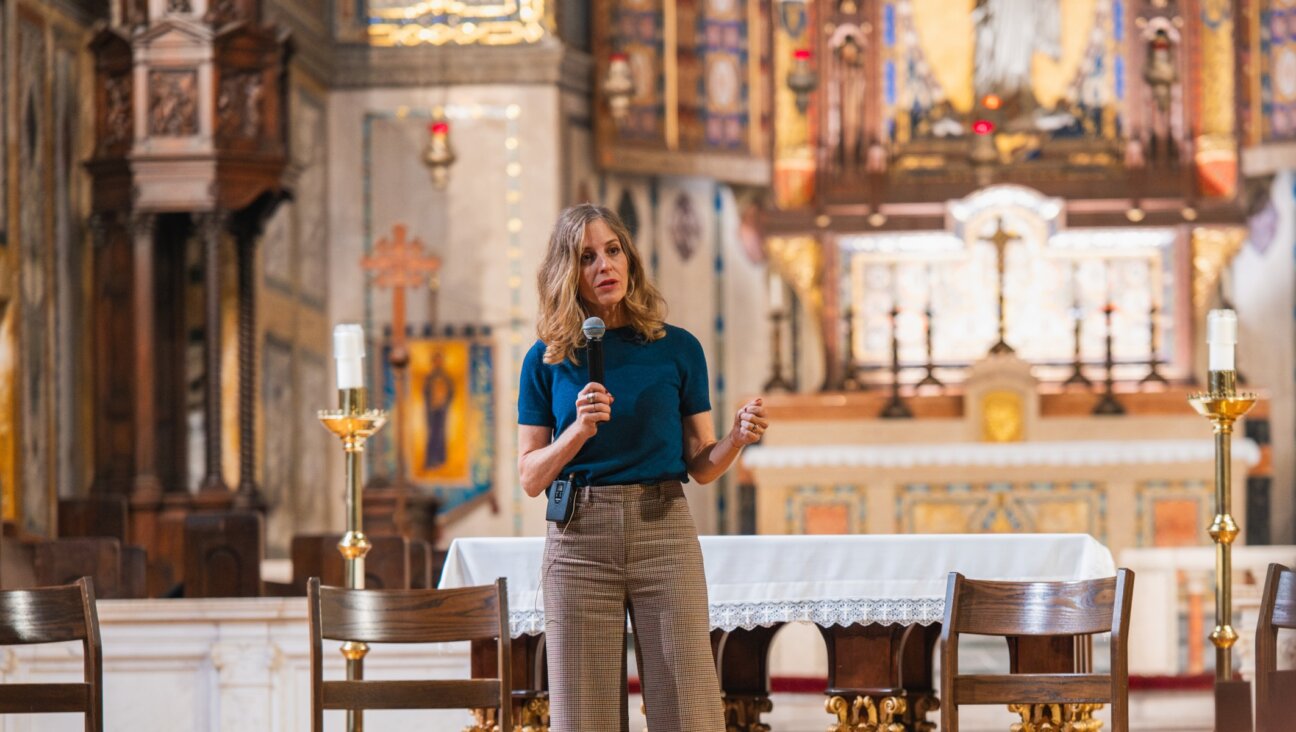Survey Shows Conservative Judaism’s Numbers Dropping
Conservative rabbis are struggling to answer a key question raised by the results of the recently released National Jewish Population Survey 2000-01: How, after decades of predominance, did they lose their claim to heading the nation’s largest synagogue movement.
The $6 million survey, commissioned by the United Jewish Communities, found that only 33% of all households belonging to a synagogue affiliated with a Conservative synagogue — a 10-percentage-point plunge from the 43% reported in the 1990 national survey. Meanwhile, the Reform movement took over first place, jumping from 35% to 39%, and the Orthodox surged from 16% to 21%.
While researchers have debated the comparability and even the accuracy of the two national studies, other surveys have pointed to similar declines in the number of Conservative Jews. The American Jewish Committee’s annual opinion surveys found that in 1991 38% of Jews identified themselves as Conservative, while in 1997 only 31% did so.
But some Conservative movement leaders disputed the notion that their overall numbers had dropped, pointing out that the UJC survey only shows a proportional decline in membership. Conservative officials attributed the drop primarily to the Reform movement’s successful outreach to interfaith families and acceptance of people born to Jewish fathers, as well as Jewish mothers.
Many top executives in the Conservative movement acknowledged that their numbers are down and said that the explanation may be more complicated than an influx of Reform interfaith families. They pointed to a failure to seed Conservative synagogues in suburbs with burgeoning Jewish communities where Reform temples have cornered the market. Conservative leaders also blamed the lack of cohesion among the various arms of their movement and called for a more unified message.
“The Conservative movement has a hard time putting forth a unified image,” said Rabbi Daniel Allen, executive vice president of the Jewish Federation of Greater Hartford and former president of the Conservative foundation that supports the movement’s Israeli wing. “There’s an organizational issue here, among others.”
Rabbi Joel Meyers, the professional head of the Conservative movement’s Rabbinical Assembly, sounded a similar note: “Maybe what we have to do is take a different internal approach, how each of the arms of the movement put forward our mission and program. I think the approaches are slightly different at times.
“Maybe we need an alignment so we are all doing and saying and acting the same way, ” Meyers continued.
Some Conservative leaders spoke of the challenges faced by a centrist movement at a time when the middle ground appears to be disappearing from many facets in American life, including religion and politics. At the same time, some observers said, the Reform movement has become more traditional and therefore more appealing to would-be Conservative defectors.
Despite the precipitous drop in percentage, however, Conservative leaders maintain that their members are more religiously committed and dedicated to synagogue life than ever before.
“We have a shrinking center and a Jewishly stronger center,” Meyers said. “All of the studies we have done indicate a stronger Jewish practice: The growth of new day schools, new day-high schools, the attendance at synagogue services, the attendance at adult educational programs, the number of our community that has increased observance of holidays, kashrut, Shabbat.”
The flip side of this view, critics say, is that the bulk of people leaving for the Reform movement are leaving because of the stricter standards in Conservative synagogues. They cite the ban on non-Jewish parents from actively participating in bar mitzvah rituals and the requirement that children attend synagogue twice each month for a year before their bar mitzvah. Critics have also complained of a behavioral and ideological disconnect between the movement’s leadership and its laity.
A few Conservative officials challenged the very notion of a drop in membership.
“I don’t see this as a decline,” said Jerome Epstein, executive vice president of the United Synagogue of Conservative Judaism, a union of 800 synagogues. “We’re just getting a smaller percentage of the pie. When the unaffiliated are choosing a place, if they’re intermarried, they may choose a Reform congregation.”
Epstein added: “If the survey is correct, that also means only one-third of intermarried Jews raise their children as Jewish. If that’s the case, I’m not sure at what expense [the Reform movement] grew.”
The relative growth of Orthodoxy, Epstein said, had also eaten away at the Conservative percentage. Orthodoxy’s apparent expansion, he added, may simply reflect past undercounts of its members.
Robert Wexler, president of the University of Judaism in Los Angeles, also questioned the figures. “I cannot account for 10%,” said Wexler, whose institution houses a Conservative rabbinical school. “That seems like a lot of Jews in 10 years.”
But even Epstein acknowledged that a “significant amount” of those who switch to Reform synagogues do so because of “commitment issues.” For example, he said, they leave because of “more demanding religious education” or because they want to get married on the Sabbath — a time when “a Conservative rabbi isn’t going to go.”
Some observers suggested that the trend toward greater tradition and ritual in the Reform movement is driven in part by an influx of people leaving the Conservative movement because of higher standards of observance and the increase in the number of intermarried families, whose participation in Conservative ritual is limited.
Rabbi Eric Yoffie, president of the Union of American Hebrew Congregations, said that about 60% of Reform Jews were raised outside the movement.
“One factor in explaining our movement to more ritual is members who grew up in more traditional homes,” Yoffie said. “I’ve often said to our congregations that you cannot have it both ways. You cannot open doors and embrace them and not expect it to have an impact on how we practice.”
But Yoffie warned against reading too deeply into the surveys’ data. He said that the tendency of the Jewish community to “jump on statistics and then use them for their own purposes” is not an “exceedingly healthy phenomenon.”
During the 2000 survey, questions about synagogue affiliation and other religious identity were not posed to a sample group representing 800,000 Jews who did not affirm their Jewish identity. Some researchers said this made it impossible to compare the 1990 and 2000 statistics on Conservative affiliation. Others said that the data was sound because the response from the unrepresented 800,000 Jews would have been irrelevant since they would not have affiliated with a synagogue if they did not consider themselves Jewish.
Steven Bayme of the American Jewish Committee said the entire 6% increase in Reform affiliation can be explained by the movement’s acceptance of intermarried couples: “If mixed marrieds are 30% of American Jewry and 20% identify with synagogues, the Reform movement has picked up an extra six percentage points,” said Bayme, national director of the AJCommittee’s Department of Contemporary Jewish Life.
Rabbi Charles Simon, executive director of the Conservative movement’s Federation of Jewish Men’s Clubs, said that his movement had not responded quickly enough to changing Jewish demographics, although he denied that the movement’s standards are driving people away.
“As the Conservative movement becomes more sensitive to rising intermarriage rates and starts to reach out to help support non-Jewish spouses to find a place for his or her family in the synagogue, it will be an opportunity for growth,” Simon said.
“Jews aren’t remaining Jews because of ties to kosher-style food; they’ve become actively Jewish,” Simon said. “It just took a little while for the movement to articulate these messages as strongly as they needed to.”
A message from our Publisher & CEO Rachel Fishman Feddersen

I hope you appreciated this article. Before you go, I’d like to ask you to please support the Forward’s award-winning, nonprofit journalism during this critical time.
We’ve set a goal to raise $260,000 by December 31. That’s an ambitious goal, but one that will give us the resources we need to invest in the high quality news, opinion, analysis and cultural coverage that isn’t available anywhere else.
If you feel inspired to make an impact, now is the time to give something back. Join us as a member at your most generous level.
— Rachel Fishman Feddersen, Publisher and CEO























